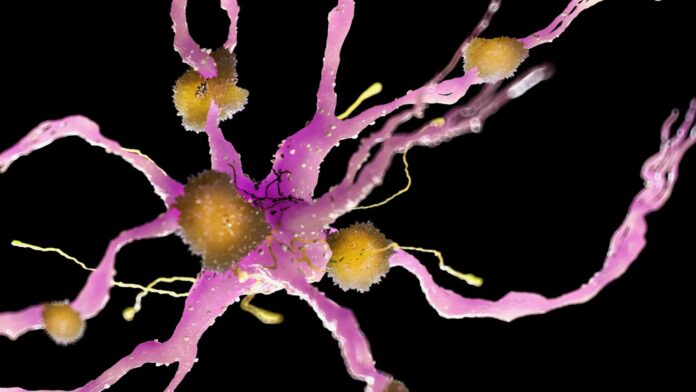Researchers in Michigan published a study “Transposable elements contribute to cell and species-specific chromatin looping and gene regulation in mammalian genomes” in Nature Communications that shows that transposable elements play an important role in regulating genetic expression with implications to advance the understanding of genetic evolution, with potential applications in neurodegenerative diseases.
Transposable elements move around the cell, and, unlike previously thought, the authors of this paper found that when they go to different sites, transposable elements sometimes change the way DNA strands interact in 3D space, and therefore the structure of the 3D genome. It appears a third of the 3D contacts in the genome actually originate from transposable elements leading to an outsized contribution by these regions to looping variation and demonstrating their very significant role in genetic expression and evolution.
The main component that determines 3D structure is a protein, CTCF. This study particularly focused on how transposable elements create new CTCF sites that, in turn, hijack existing genomic structure to form new 3D contacts in the genome. The scientists demonstrate that these often create variable loops that can influence regulatory activity and gene expression in the cell. These findings were observed in human cells and mouse cells and show how transposable elements contribute to intraspecies variation and interspecies divergence and will guide further research efforts in areas including gene regulation, regulatory evolution, looping divergence, and transposable element biology.
“Chromatin looping is important for gene regulation, and studies of 3D chromatin structure across species and cell types have improved our understanding of the principles governing chromatin looping. However, 3D genome evolution and its relationship with natural selection remains largely unexplored. In mammals, the CTCF protein defines the boundaries of most chromatin loops, and variations in CTCF occupancy are associated with looping divergence. While many CTCF binding sites fall within transposable elements (TEs), their contribution to 3D chromatin structural evolution is unknown,” write the investigators.
“Here we report the relative contributions of TE-driven CTCF binding site expansions to conserved and divergent chromatin looping in human and mouse. We demonstrate that TE-derived CTCF binding divergence may explain a large fraction of variable loops. These variable loops contribute significantly to corresponding gene expression variability across cells and species, possibly by refining sub-TAD-scale loop contacts responsible for cell-type-specific enhancer-promoter interactions.”

With a background in computer science and molecular biology, Alan Boyle, PhD, assistant professor of computational medicine and bioinformatics, and assistant professor of human genetics, at the University of Michigan, explains that he has always been interested in gene regulation. “It’s like a complex circuit: perturbing gene regulation through changes to the three-dimensional structure of the genome can have very different and wide-ranging outcomes,” he said.
For Adam Diehl, PhD, research computer specialist in the Boyle Lab, this research continues the discoveries that started in the late 1800s, when scientists first looked at the shape of chromosomes through microscopes. They observed the shape differences between cells and noticed that the shape inside the nuclei remained the same between mother and daughter cells. Decades later, transposable elements were discovered at his alma mater, Cornell University: jumping genes could change the phenotypes of corn plants.
In the 70s, because the genes between humans and chimpanzees are much too similar to explain the differences between the species, scientific focus shifted on how the genes are being used. For Diehl, “It’s so exciting to be able to synthesize all this knowledge and contribute to the next step of the story of species evolution,” he said.
The research team will further study the impact of transposable elements on the 3D genome, but this time with a particular interest on a single human population sample rather than across species. The next steps will include experimental follow-up using a new sequencing method capable of identifying transposable element insertions that are variable across human populations. This method was developed in collaboration with Ryan Mills’ lab, at the University of Michigan, Medical School. It is expected that the next results will further the understanding of the regulatory role of the transposable elements with possible applications to neurodegenerative diseases.





